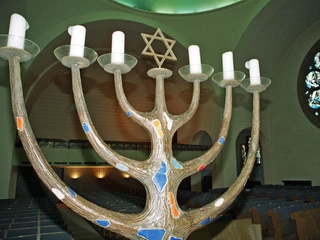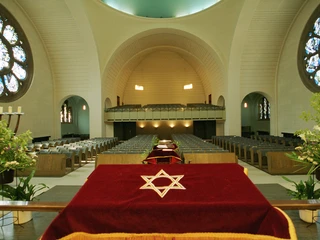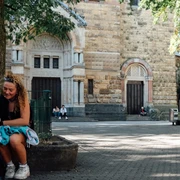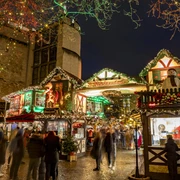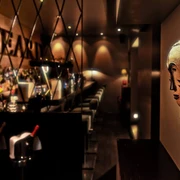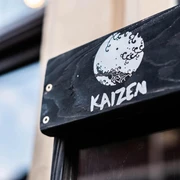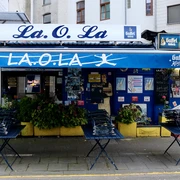- Photos & Map
How would you like to arrive?
- Call
- Details
- Useful Information
- Nearby
The synagogue on Roonstraße is the only one of Cologne’s six synagogues that was rebuilt after the Second World War. But Jewish life in Cologne has a long tradition. In fact, Germany’s oldest documented Jewish community lived in Cologne. In addition, in the 13th and 14th centuries this metropolis on the Rhine was regarded as the spiritual centre of Judaism in Germany. One of the oldest surviving mikvas, dating back to the eighth century, is located in Cologne.
The great Cologne synagogue, which was built between 1895 and 1899, was severely damaged, along with all of Cologne’s other synagogues, during the Reichspogromnacht (the November pogroms in 1938). It was burned down to its foundation walls. After the war, Konrad Adenauer advocated the rebuilding of the synagogue during the 1950s. It was possible to reconstruct the exterior according to its original historical appearance.
The interior, in contrast, was completely redesigned. Many cultural events are held here throughout the year. If you sign up for a public guided tour through the great synagogue, you’ll have an opportunity to find out more about its construction and its history. Pope Benedict XVI visited the synagogue on Roonstraße on World Youth Day in 2005. This was a very special occasion, because it was the first time a head of the Roman Catholic Church had visited a synagogue.
The prayer room offers 800 seats for men and 600 seats for women. This is where the Torah that was created in 1902 is once again being used in the liturgy. It was restored in 2007 at a cost of €12,000, paid by the Archdiocese of Cologne.
The Jewish welfare centre in the Neuehrenfeld district houses other related facilities, such as a primary school, a children’s daycare centre and an old age and nursing home. The administrative offices and social counselling services are also located here.
The synagogue’s architecture is definitely worth a visit. In October 2020 the City of Cologne authorized €42 million for the remodelling of the synagogue in line with the standards for protected historical monuments. Plans call for the roof, the dome, mosaics in the interior and the windows to be restored in a modernized form.
The great Cologne synagogue, which was built between 1895 and 1899, was severely damaged, along with all of Cologne’s other synagogues, during the Reichspogromnacht (the November pogroms in 1938). It was burned down to its foundation walls. After the war, Konrad Adenauer advocated the rebuilding of the synagogue during the 1950s. It was possible to reconstruct the exterior according to its original historical appearance.
The interior, in contrast, was completely redesigned. Many cultural events are held here throughout the year. If you sign up for a public guided tour through the great synagogue, you’ll have an opportunity to find out more about its construction and its history. Pope Benedict XVI visited the synagogue on Roonstraße on World Youth Day in 2005. This was a very special occasion, because it was the first time a head of the Roman Catholic Church had visited a synagogue.
The heart of Jewish community life in Cologne
The building on Roonstraße, opposite Rathenauplatz, not only serves as a place for religious services but also combines a whole range of other facilities: the kosher restaurant Mazal Tov, a small museum, a library, a youth centre and a ceremonial hall. A tour through the synagogue offers insights into Jewish intellectual life, religious beliefs and history, as well as Jewish life in Cologne.The prayer room offers 800 seats for men and 600 seats for women. This is where the Torah that was created in 1902 is once again being used in the liturgy. It was restored in 2007 at a cost of €12,000, paid by the Archdiocese of Cologne.
The Jewish welfare centre in the Neuehrenfeld district houses other related facilities, such as a primary school, a children’s daycare centre and an old age and nursing home. The administrative offices and social counselling services are also located here.
Built in the neo-Romanesque style
The synagogue on Roonstraße was built in the neo-Romanesque architectural style. In this 19th-century style in Europe, architects primarily drew on models that went back as far as two thousand years. Like the cathedral in Marseille, the garrison church in Dresden and the Saint-Pierre-le-Jeune church in Strasbourg, the Jewish synagogue in Cologne combines a wide spectrum of styles from past epochs. For example, the arched windows, the pyramid roof and the slim corner turrets are modelled on typical elements of Byzantine architecture.The synagogue’s architecture is definitely worth a visit. In October 2020 the City of Cologne authorized €42 million for the remodelling of the synagogue in line with the standards for protected historical monuments. Plans call for the roof, the dome, mosaics in the interior and the windows to be restored in a modernized form.
The synagogue of the largest Jewish community in Germany
The Jewish community in Cologne, which has about 4,000 members, is the biggest in Germany — and the oldest Jewish community north of the Alps. In the 1990s the Jewish community in Cologne expanded rapidly due to the arrival of many Jewish people from the former Soviet Union. As a result of this new set of needs, the community’s infrastructure was expanded. Thus other facilities, such as the welfare centre and the community centres in the Porz and Chorweiler districts of Cologne are linked with the centre.Guided tours through the synagogue and the Jewish cemeteries in Cologne
Group tours take visitors through the great synagogue and the Jewish cemeteries in the Deutz and Bocklemünd districts. The cemetery in Deutz is Cologne’s oldest Jewish cemetery. When you register for one of the public tours, please keep in mind that male participants must wear a head covering. You also need to present your identity card or passport.The future is still exciting — and Jewish life in Cologne is vibrant: the MiQua
In 1956 excavations in the area around Cologne’s Historic City Hall led to the discovery of a Jewish mikva, or ritual bath, that was more than 900 years old, as well as a synagogue from the 11th century. Currently under construction is the new MiQua Museum, which will showcase the Roman Praetorium and parts of Cologne’s medieval Jewish quarter as well as other testimonies of Jewish culture.Useful Information
Eligibility
Suitable for any weather
for families
for individual guests
Parking facilities
From (H) Zülpicher Platz to the synagogue is about 400 meters.
Nearby

